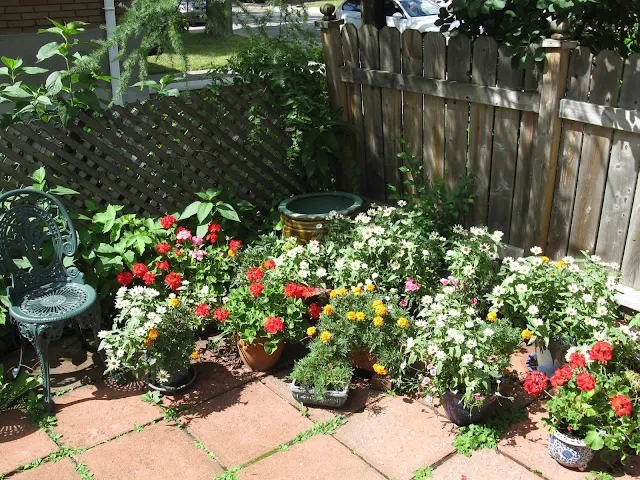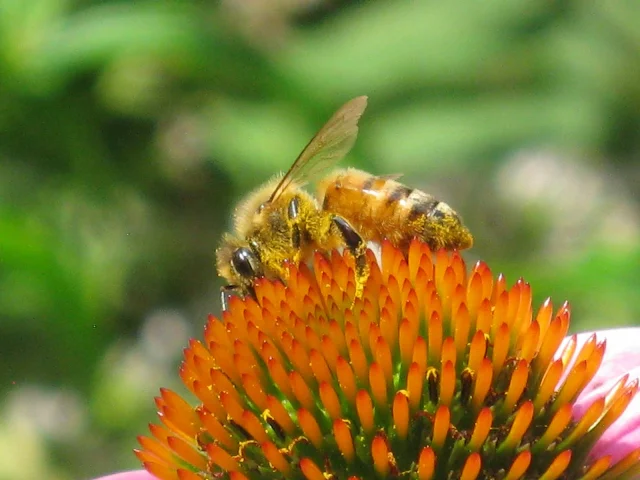Sunday, August 1, 2021
Wednesday, July 28, 2021
"In an English Country Garden"...
 |
Here are two flower pots that had hyacinthes in them when they were given to us years ago. I found the metal tray in someone's garbage and the pots fit in it very nicely. |
The cottage garden, the country garden, Percy Grainger's "In an English Country Garden", just writing the title of this piece of music causes me to hear it in my mind and to sing it to myself.
When you set out to plant a cottage garden you will probably say goodbye to annuals; for the most part annuals and a cottage garden are mutually exclusive but there are, of course, exceptions. You will save a bundle by planting perennials and have, in my opinion, a much nicer garden. Begin with cone flowers, move on to other daisies, and then aim to plant all of the other flowers that go into a cottage garden. I will make a list of these flowers but you've probably heard of all of them and you will see how simple it is. This will cost a few hundred dollars the first year but amortized over several years it is not costly and the enjoyment far exceeds the cost. As well, these plants multiply and soon, as I did last fall and this spring, you will be transplanting cone flowers, daisies, and bee balm to other parts of your garden. The cost is free; the return is immense.
A true cottage garden doesn't have a lawn and that is what I am working towards, when that happens there will be foot paths and much more garden and much less grass. Grass is not a flower although people love their lawns. I, too, like a nice lawn but I like a cottage garden even more.
Last fall I dug up some grass and moved daisies to the new flower beds. I moved cone flowers, daisies, bee balm, ornamental grass, and holly hocks to the new flower beds; the result has been better than I ever expected. I have a lot of shade in this garden, too much shade, and the new garden plot is in the full sunlit part of the garden. I would like to have a huge bank of daisies as I've seen in other cottage gardens but without a lot of sunlight this seemed a difficult feat to achieve, now it's possible that in a year of two, enlarging the new flower beds, I will have quite a terrific display of daisies, bee balm, cone flowers, and others.
Tuesday, July 27, 2021
Monday, July 26, 2021
The cottage garden is all for peaceful co-existence
I think I could turn and live with animals,
Make your cottage garden as inviting to animals, birds, and insects as possible. Birds will use the bird bath and ignore you. Butterflies might land on your shoulder. The honey bees will continue to visit the flowers; bumble bees, that used to be so common but are now increasingly rare, will visit your garden and enjoy the bee balm. At night, in July, fire flies will make your garden a place of magic and wonder.
Sunday, July 25, 2021
The Canadian Cottage Garden
Everything is the best ever this summer; I am referring to the garden. I have never seen the garden so full of flowers as this year; I keep saying to my wife that it is paradise out there, it is the Garden of Eden.
The Canadian author, W.P. Kinsella, who wrote Shoeless Joe, from which the film Field of Dreams was adapted, wrote something like, "if you build it, they will come." Of course, it is true, including in gardening. If you want birds to visit your garden, have a bird feeder; better yet also have a bird bath with clean water in it every day. If you want insects, butterflies, bumble bees, honey bees, have a lot of flowers and the insects will come. If you want life, then plan ahead and make your backyard inviting for living beings.
Your backyard, which was barren, just a lot of half dead grass and dirt, desolate and uninviting, can be transformed into a place that is full of life and activity, as I have done with our backyard. Yesterday, I sat in our backyard with my son who was visiting; right away he knew it was a cottage garden that I had aimed for (he hadn't visited for almost two years due to Covid-19). The work I put in for the last five or more years was finally evident. You can transform just about any piece of land into your own Garden of Eden. If you work on it, flowers will grow, the birds and insects will return. Even urban wildlife will stop by and visit; in the middle of last night I woke up to the smell of a skunk, but there are other nocturnal animals making their way through the garden, including raccoons and ground hogs.
Here are some photographs taken this week of honey bees on echinacea flowers, cone flowers, that I planted a few years ago. Having been a beekeeper many years ago I always love to see honey bees in the garden, not because they are important pollinators, which they are, but because I have a lot of affection for honey bees; they're busy working, they won't sting you, it is live and let live in this life.
 |
| Notice the bee's back legs, the pollen sacs are for collecting pollen which is protein for honey bees |
Bird bath time
A cottage garden should have some display or presence of water. If you live in the city it's unlikely you will have a stream or creek running through your backyard; I am not too big on fountains or artificial waterfalls although it's a possibility; so the easiest display of water is a bird bath. Birds love to visit a bird bath and sit in the water, they dunk their heads under the water, flap their wings, and then depart. It is a source of endless entertainment. Why do birds take baths? I am not too sure that science has studied this much; even in the fall I've seen birds in this bird bath. Curious, isn't it?
 |
| A robin having a cooling bath. |
 |
| I am a paparazzi of birds bathing in public, there is no privacy anymore... |
Friday, July 23, 2021
Sunlight, Water, Soil, Plants
For a good garden you need at least three of four things: sunlight, water, good soil, and healthy plants.
Not much sunlight, then plant hostas.
No tap water, then collect on rain water.
Soil problems, try making compost or buy bags of soil.
If you need more plants for your garden, then it's time to go to a garden center, or maybe someone will give you seeds or plants from their garden.
Miss these ingredients and it will be difficult to have the garden you want.
 |
| Bee balm |
 |
| Cone flowers |
 |
| Day lilies, bee balm |
 |
| Bee balm, day lilies |
Monday, July 19, 2021
Some flowers in the Canadian Cottage Garden
I began making a list of plants that are traditionally found in cottage gardens. Some plants flower in spring, more flower in summer, and some plants are still flowering to fall. A lot of what I do, as a gardener, is by chance, by serendipity. There are different variables that will affect your garden, including weather, insects, how much time one has to garden, and so on. Here are some spring flowers: apple blossoms, bleeding hearts, snow drops, lilacs, forsythia, tulips, and others. Then, in summer, we have roses, peonies, miniature irises, snow ball hydrangeas, day lilies, fox glove, different varieties of hostas, lavender, shasta daisies, gloriosa daisies, cone flowers, bee balm, raspberries, clematis, and others. You want to stick with perennials over annuals, but biennials like Sweet Williams and holly hocks will add a lot to a garden. Self seeding plants are always welcome including, by the way, plants that migrate to your garden from your neighbour`s yard. I have forgotten or left out other plants I've grown and will try to include them here at a later date. Something could be written about every plant or tree or bush mentioned here and possibly will be.
 | ||
Bleeding heart
|
 |
| Here is a hosta in early spring |
 |
| Apple blossoms |
 |
| Forsythia bush |
 |
| Tulips |
Monday, July 12, 2021
In the Garden
 |
We don't have a large backyard, which in some ways is perhaps an advantage. The main disadvantage is that it is quite shady. This photo was taken in early November 2009. |
 |
Before I began working on the back yard garden I planted pots on the patio. July 2011 |
 |
Back yard in July 2011 |
 |
Our ginkgo tree, on our front lawn, July 2011; not sure if it was planted in 2009 or 2010 |


































